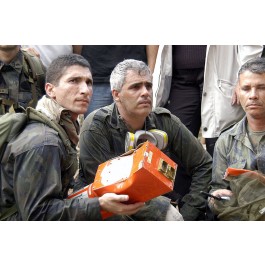|
|
EmergenciesDescriptionInstruction in emergency procedures should not be limited to simulated emergency landings caused by power failures. Other emergencies associated with the operation of the airplane should be explained, demonstrated, and practiced if practicable. Among these emergencies are such occurrences as fire in flight, electrical or hydraulic system malfunctions, unexpected severe weather conditions, engine overheating, imminent fuel exhaustion, and the emergency operation of airplane systems and equipment."Unskilled" pilots are always found in the wreckage with their hand around the microphone. Here is a great quote by Len Morgan: "An airplane might disappoint any pilot, but it'll never surprise a good one." The steep spiral can be used for an emergency descent. Click on the emergency descent link below for some thoughts on the emergency descent. The prop! Hand propping! From the NTSB site. Aircraft: CESSNA 150M, registration: N714QW. Injuries: 1 Serious, 1 Uninjured. THE STUDENT & INSTRUCTOR (CFI) WERE PREFLIGHTING THE ACFT TO FLY ON A COLD MORNING. TO FACILITATE BETTER ENG STARTING, THE CFI ELECTED TO TURN THE PROP WHILE THE STUDENT 'PUSHED THE PRIMER IN.' HE TOLD THE STUDENT TO CHECK THAT THE MAG & MASTER SWS WERE OFF & THE STUDENT ACKNOWLEDGED. ON THE 2ND 'TURN THROUGH,' THE ENG STARTED & RAN APRX 5 SEC. THE CFI WAS INITIALLY CLR OF THE PROP, BUT AS HE WAS BACKING AWAY, HE SLIPPED ON INCE & HIS RGT LEG WENT IN THE PATH OF THE TURNING PROP. HE WAS HOSPITALIZED WITH A SEVERE LACERATION & THE PROP WAS SLIGHTLY BENT. AN INV REVEALED THE STUDENT WAS AT THE CONTROLS WITH THE KEYS REMOVED FROM THE MAG SW. A FURTHER EXAM REVEALED THE MAG CIRCUITRY WAS NORMAL, EXCEPT THE MAGNETO KEY COULD BE REMOVED WHILE THE MAG SW WAS IN THE 'LEFT' POSITION. StudentPilot, PrivatePilot, CommercialPilot, InstrumentPilot, InstrumentRating, CFI, FlightInstructor, PvtLP, InstLP, ComLP, CFILP, CFIILP, MultiLP, MEILP, SeaplaneLP, MiscLP Detailed Information
|









